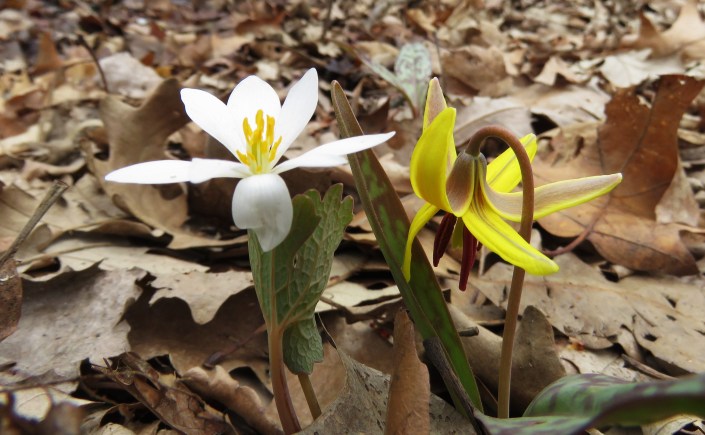The season of spring ephemeral wildflowers is well-underway and is reaching its peak in the southern part of our county; but there’s still a way to go in the northwoods of Oakland County. However, if you wait too long for a woodland walk, you will miss this colorful short-lived show of nature’s spring ephemerals altogether. But just what is a spring ephemeral?
When the word ephemeral is used to describe wildflowers, it means the blossoms are short-lived. The word ephemeral was originally a medical term meaning “lasting only one day.” Ephemeral is not used very often in relation to woodland wildflowers, but it’s an accurate and descriptive word since woodland wildflower blooms last only for a very short time, and some only for a day.
Ephemeral woodland wildflowers are now in full bloom in southernmost Oakland County down at the Tenhave Woods Nature Preserve in the City of Royal Oak. Many of the photos I am sharing today were captured at Tenhave Woods.
I’ve noticed a steady but slow emergence of Bloodroot; one of my favorite ephemerals at the Ortonville and Bald Mountain State Recreation Areas, and in the woods behind my house. Wait a week or two to see spring ephemerals in bloom and you will miss the show! What follows are some photos of our hidden beauties to pique your interest and then perhaps it’s time to go for an eyes-to-the-ground hike on the wilder side of Oakland County and see what you can find, but don’t pick! They would be withered away before you got home; and it is illegal to pick wildflowers on state lands and in most parklands as well.

BLOODROOT: This rather fragile flower of early spring that is a member of the poppy family rises from the center of a curled leaf. It opens in full sunlight and closes at night. The scientific name Sanguinaria canadensis and the common name bloodroot refer to the blood-red sap that is found in all parts of the plant. The sap is especially noticeable in the root-like rhizome of the plant. Bloodroot is blooming now but it won’t last long.

TROUT LILY: This stunning wildflower earned its name because of purple splotches on the leaves that bear a casual resemblance to the markings of a brook trout. It’s all known as adder’s tongue. The beautiful nodding yellow flowers in our shaded and fertile woodlands sometimes appear in large clusters that may cover hundreds of feet. It blooms before the surrounding trees leaf out.

SPRING BEAUTY: The name says it all. It is a very small delicate beauty of spring that can be overlooked when growing in small clumps. I’ve noticed they often appear next to hardwood trees or adjacent to a fallen log. I’ve never seen one near evergreen trees.

RED TRILLIUM: Red trillium, which also has the common name Stinking Benjamin, has started to bloom and draws not only the human eye, but also flies. It’s a beautiful flower with an intriguing but highly effective method of pollination; thus, the name Stinking Benjamin. If you bend over and sniff the bloom you will detect a rather putrid odor that resembles decaying meat and as result attracts flies; and the flies serve as their pollinators.

WHITE TRILLIUM: White trillium thrives across much of Michigan and does very well in shady hardwood forests. It’s a long-lived perennial wildflower and it’s rare to see just a few in one location. They often cover hundreds of feet in well drained deciduous woods. If you ever make it up to Sleeping Bear Dunes National Lakeshore you notice patches of these flowers covering more than an acre.

MAY APPLE: This common often overlooked wildflower of the woodlands has a long way to go before the hidden “apple” under the broad leaves appears. Give it a few more weeks of warmth and it becomes far more noticeable. It flowers in spring and the fruit ripens in late summer.

DUTCHMAN’S BRITCHES: Even the name Dutchman’s Britches is eye-catching, and it is a well-deserved name. It’s been blooming for a few weeks but won’t last much longer. The flowers are white but sometimes tinged with pink and have a strong resemblance to a pair of upside-down hanging pantaloons. When pointing out the flowers to young children, I say they look a tiny bit like a pair of baggy upside-down pants. That increases their enthusiasm and often brings giggles.

JACK-IN-THE-PULPIT: This is one of my favorite late spring wildflowers. It’s abundant in my woodland, but has barely started to emerge this year. As for its odd name; the flower stalk is enclosed and covered by a downward leaning striped sheath known as the pulpit.
Perhaps today will be a good day for a woodland meander in one of our Oakland County Parks, Huron-Clinton Metro Parks or Michigan DNR State Recreation Areas with an eye out for our woodland wildflowers. Just be sure to remember wildflowers on public lands are not collectible; but they can be fun to photograph.

Jonathan Schechter is a naturalist, eagle watcher and nature education writer for Oakland County Government and blogs about nature’s way on the Wilder Side of Oakland County.
Follow along with Oakland County on Facebook, Instagram, LinkedIn, Pinterest, Twitter, and YouTube using #OaklandCounty, or visit our website for news and events year-round.

